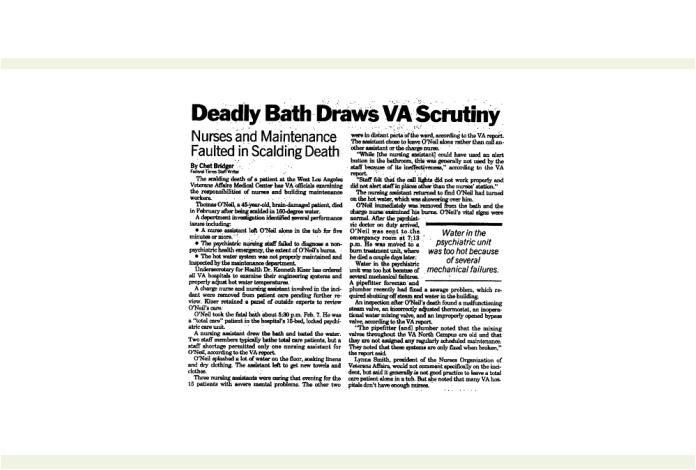
water quality and system
.pdf
< previous page |
page_103 |
next page > |
Page 103
Insulation
Once the water is hot, it should immediately be used. Thermal insulation, however, can be provided to keep the water warm and reduce the loss of heat. Several types of insulation are used, with foam and fiberglass being the two most common types. Usually, the insulating material is coated with a protective outer layer to protect the insulation from damage.
The thickness of the insulation is a function of the material's ability to resist heat transmission away from the material in contact with the heated water.
Most insulation materials are essentially air-encapsulating. That is, air is trapped in the insulation material and it is the air that acts as the insulating medium.
In the past asbestos was used as an insulating material on hot water tanks and pipes. Many older facilities had significant amounts of asbestos but much of it has been identified and removed in the past 10 years. Asbestos is a known cancer-causing material with the greatest risk coming from inhaling the fibers. The government has made funds available for asbestos removal and if a facility manager suspects asbestos has been used in insulating materials, the state agency for managing asbestos removal will be able to assist by providing training and funds for asbestos removal.
If a facility has asbestos insulation, steps should be taken immediately to keep insulation from becoming airborne. This can be accomplished by encapsulating the insulating materials in plastic or another suitable cover, but these types of activities should be conducted by properly trained personnel to minimize the risk to the workers as well as the risk of lawsuits to the facility.
Fiberglass, similar to asbestos but not hazardous, can be encapsulated to prevent loose fibers drifting in the air of the facility.
Pipe hangers and supports should hold the insulation, and not contact the hot water pipe directly.
Safety
The facility should include the necessary safety items on a hot water system to protect both the facility and the workers. Of the greatest significance with hot water tanks are the requirements for pressure and temperature relief if the heating equipment should break down and overheat the water.
Pressureand temperature-relief devices must be the proper size.
< previous page |
page_103 |
next page > |

< previous page |
page_104 |
next page > |
Page 104
An undersized relief device does not allow the hot water out of the tank quickly enough. The risk from an undersized pressure relief device is just as great as if the device were not installed.
Water Heating Safety Standards
For water heating equipment, several industries study and recommend safe practices and standards. The American Society of Mechanical Engineers publishes the Boiler and Pressure Vessel Code. Most safety devices are tested and will have a label or sticker on them. Most common symbols are the UL labels provided by Underwriters Laboratories, Inc. The manufacturer submits his product to, and in most cases pays for, its equipment to be tested under rigorous conditions. The tests are usually required by the manufacturer's insurance company to protect manufacturer's liability. The facility manager should be aware that hot water relief devices and thermostatic controls of burners are subject to these requirements. If the facility does not use tested and approved devices, the risk and liability of the facility is increased dramatically.
Temperature Control
In addition to pressure and temperature relief, electrical instruments are used to control the heating elements. These devices should automatically shut off the heat if temperatures or pressures are exceeded.
Valves
Hot water system valves are the same as the ones used for cold water, and valves should be provided to isolate sections for maintenance while other parts can be left on line. For example, hot water recirculating pumps are duplicated in facilities where hot water use is criticale.g., hospitals. Valves should be installed to isolate one pump for maintenance service while the second one provides hot water throughout the facility.
Instruments
Pressure and temperature gauges are usually provided on large hot water tanks. In addition, fuel pressure gauges and flowmeters are sometimes installed. Recent electronic trends have led manufacturers to provide computers that record the uses of hot water.
< previous page |
page_104 |
next page > |

< previous page |
page_105 |
next page > |
Page 105
The most sophisticated of these programs ''remembers" when hot water is used and adjusts the thermostats accordingly. Computers can set the thermostats back on nights or weekends to conserve energy and save hot water heating costs.
A good example of this type of system might be a school where hot water is needed during the week for meals and students' showering needs. On the weekend, however, hot water use is curtailed because the use of hot water is reduced. The computer program "remembers" that on Monday school starts again and begins bringing the temperature up late Sunday eveningwhen school begins, the entire hot water system is ready for a busy day.
Maintenance
Another method of providing hot water during a major maintenance activity is contracting for hot water services from a vendor. A temporary tank and heater is set up and water lines are run from inside the facility out to the temporary equipment where it is heated. The hot water is then tied back into the system downstream from the hot water equipment needing work.
< previous page |
page_105 |
next page > |

< previous page
< previous page
page_106
Figure 6-3.
News article "Deadly Bath Draws VA Scrutiny." Courtesy: ©1995, The Federal Times Newsletter.
page_106
next page >
Page 106
next page >

< previous page |
page_107 |
Case Study: Water Too Hot at VA Hospital
The newspaper article shown in Figure 6-4 indicates what can happen to a facility that fails to manage its hot water supply system properly. The article relates the death of a mental patient who was left alone in a bathtub for a few minutest. While alone, the patient turned on the hot water shower, scalding himself. The burns were extensive and the patient died a few days later. As can be seen from the attached article, infighting between the hospital nursing staff and the facility maintenance personnel exists as to whether the hot water system was properly maintained.
Hospitals have standards for maintaining hot water temperatures at about 105 degrees to prevent scalding of patients. The latter part of the article indicates several maintenance problems that are discussed here item by item:
1. "A pipefitter foreman and plumber had recently fixed a sewage problem which required shutting off steam and water in the building."
This would be normal. Systems have to be periodically shut down for maintenance. Procedures usually require the staffs to be notified when systems are going to be shut off to enable the staff to make the necessary adjustments to their plans. Often, however, staff notification means notifying the supervisor. If the supervisor in turn does not inform his own staff, the effect of notification is lost.
2. "An inspection after the patient death found a malfunctioning steam valve ..."
Again, not a disastrous condition by itself. Steam valves and other types of valves malfunction and, provide the maintenance staff is trained, the system can continue to operate until maintenance is scheduled
3. "... an incorrectly adjusted thermostat ..."
Depending upon the circumstances, this would be highly irregular in a hospital caring for mental patients. The articles does not indicate, however, if this were the only use. For example, if the kitchen were served with this same water, the thermostat could have been set high for food preparation or dishwashing. In general, management should have been informed when hot water thermostat temperatures are raised. It is likely that a logbook may record the setting, time and date when it was changed.
Facility managers should make sure that accurate records are kept, that the maintenance staff recognizes the implications of deviating from established norms, notifies higher management when they do, and has the authority to make the changes.
(text box continued on next page)
< previous page |
page_107 |
next page >
Page 107
next page >

< previous page |
page_108 |
(text box continued from previous page)
4."... an inoperational water mixing valve ..."
The maintenance staff may have not have been aware that this valve was not operating until after the event. In this situation. the maintenance staff has to rely upon the user to call and notify them that the water is too hot. Since the incident occurred at 5:30 p.m., it is likely that shifts had changed and the incoming staff was not aware of the current condition of the system.
5. "... and an improperly opened bypass valve."
6. Finally, the article indicates that "mixing valves were only fixed when broken," implying that there may not have been a routine program for maintenance. However, journalistic license may again be at work because routine maintenance could be as simple as checking the hot water at the faucets.
If a facility manager is not aware of it already, there are lots of opportunities for secondguessing after the fact. The Veterans Administration has the unfortunate position of having each event that occurs broadcasted for the nation to see. Facilities should learn what they can from a tragic event or an upset condition, and get on with business as quickly and quietly as possible.
< previous page |
page_108 |
next page >
Page 108
next page >

< previous page |
page_109 |
next page > |
Page 109
Chapter 7
Regulations
History has shown that a government that fails to protect its water supply pays a heavy price in disease, sickness, pain and sorrow among its citizens. Because clean water is critical to health, government protects its citizens by enacting laws that control purification, storage, waste and ownership. Understanding these regulations is essential to complying with regulations and avoiding costly penalties.
Law and Regulations of Water Systems
In modern countries, the penalties for violation of water law vary from cease-and-desist orders or minor fines to imprisonment. Fortunately, most government regulators have learned that the people are best served if the regulations are applied proactively to prevent water purity violations. For example, if somebody pollutes five miles of river and is caught, does imprisonment restore the river? Facility managers profit from working with the local environmental regulators, provided the regulators demonstrate a level of maturity in administering and enforcing their rules.
It is unfortunate, but in a few cases, government environmental programs have not yet grown from the emotional to the scientific maturity. Regulation is administered with a "now we've got you" mentality.
Government regulation of water starts at the local level, and expands to the state and federal levels. In the United States, federal regulations such as the Safe Drinking Water Act, allow the federal
< previous page |
page_109 |
next page > |

< previous page |
page_110 |
next page > |
Page 110
government take swift action if the public health is threatened.
In addition to the federal and state environmental laws, local government has building codes and standards that govern the installation of piping systems that carry and store water.
Federal Water Laws
Several federal water laws are summarized here. These regulations are nationally applied and are published in the United States Code. It has been the policy of the United States to allow individual states to manage their own water quality, supplies and pollution programs, provided they are at least as stringent as the federal ones.
Federal water laws are administered by the United States Environmental Protection Agency. Under the law, the individual States assure compliance. Violators can be imprisoned or fined.
Since water laws are updated and amended regularly, a potential facility violation should be referred to legal counsel. Most federal water pollution law is published in Chapter 40 of the Code of Federal Regulations. Maximum fines and penalties are shown in Table 7-1.
Table 7-1. Maximum civil and criminal penalties for environmental violations.
|
|
Action |
|
Environmental Law |
Non- |
Willful/Negligent |
Withheld/Falsified |
Violation |
Information |
||
|
compliance |
|
|
Safe Drinking Water Act(SWDA) |
$25,000/day __ |
__ |
|
Resource Conservation And Recover), Act$25,000/day $50,000/day |
$25,000/day |
||
(RCRA) |
Injunction |
5-year prison |
2-year prison |
Comprehensive Environ-mental |
$25,000/day |
$25,000/day |
$25,000/day |
Response,Compensation And Liability Act |
1-year prison |
1-year prison |
|
(CERCLA) |
|
|
|
< previous page page_110 next page >

< previous page |
page_111 |
next page > |
Page 111
The Clean Water Act
Until the late 1960s, clean water was a matter for state control. Individual state regulations managed water pollution, but problems between states and definitions of what really constituted polluted water led to difficulty in agreement and commitment in efforts to clean up polluted waters.
One of the first of a new age of modern water laws was the passage of the Water Pollution Control Act by the United States Congress in 1972. The Act set basic standards against pollution of the nation's rivers and streams. In 1977, Congress revised the Water Pollution Control Act, adding toxic water pollutants to the list and renaming it the Clean Water Act (CWA). The Clean Water Act continues to be revised and amended with the most recent attempt in 1995. Unfortunately, the legislation got bogged down, again over the definitions of "pollution" and "enforcement." The revisions died in legislative session. Some environmentalists were calling it the "Dirty Water Act.''
The existing law provides funds in the form of grants to help communities pay for treatment plants in order to clean up some of their water. This legislation is called the revolving loan fund. Currently, the U.S. EPA makes these funds available to the states which in turn provide the funds to communities. In 1995, Congressboth the U.S. House of Representatives and the U.S. Senateproposed to reduce the budget of the U.S. EPA significantly. U.S. EPA administrators felt that this would seriously deplete these revolving loan funds available for the states. As a result, and due to other factors, President Clinton vetoed the appropriations bill when it came over from the Congress. Much political wrangling occurred. Regardless of the outcome in recent legislation bickering, it appears inevitable that the U.S. EPA's funds will be reduced to a lower level and that facilities will be less likely to tap the U.S. EPA for funds. The states might be willing to pick up some of this burden, but it will take time while politicians determine just where the funds will come from.
The National Pollution Discharge Elimination System
Another element of the 1972 Clean Water Act established a permit system requiring facilities to register their pollutant discharges. The intent was to regulate wastewaters and to document several unknowns, at that time, about the releases. Unknowns included the volume of the releases and the constituents of the pollutants in the release. This permission process, still intact, is called the National
< previous page |
page_111 |
next page > |

< previous page |
page_112 |
next page > |
Page 112
Pollution Discharge Elimination System (NPDES). NPDES also set limits on certain types of pollutants.
For facility managers, NPDES regulations clarify that discharges into a system served by a publicly owned wastewater treatment plant are not subject to the requirements of an NPDES permit. This means that facilities hooked to public sewer system are not subject to federal NPDES permit requirements. However, the facility is still responsible to prevent pollutants that can have an adverse effect on the sewer plant operation. In addition, discharges from the wastewater treatment plant are regulated by the NPDES requirement.
The U.S. EPA has delegated the responsibility of permit issuance to some of the states, but in others, the U.S. EPA regional offices still manage the permit program because some states have not been willing to take over and run the program on its own.
Regardless of who issues the permits, an application is transmitted from the regulatory agencyeither the state or the U.S. EPAto the U.S. Army Corps of Engineers (COE) which examines the application and determines whether the discharge would have an impact on interstate waters. If the COE finds that there is an impact on interstate waters, the COE directs the facility to perform studies to determine the scope of the impacts. The COE then checks the data and confirms the studies.
If this seems like of lot of red tape, it is. But facilities should remember that before this legislation, many streams and lakes were strangling in a sea of pollution and the costs to clean it up so far have been staggering. The effect of the Clean Water Act and NPDES has cleaned up a lot of polluted water and has notified the public of a number of waste discharges that before that time had remained largely unknown.
As recently as September 1995, the city of San Diego was potentially liable for a large fine as a result of unauthorized discharges stemming from a July 1994 waste discharge incident. Figure 7-1 is a copy of a press release published in a trade magazine as a warning to all facility managers.
The Safe Drinking Water Act
Originally passed in 1972 and amended in 1986, the Safe Drinking Water Act (SDWA) was designed to protect drinking water supplies. In contrast to the Clean Water Act, which primarily regulates pollutant discharges, the Safe Drinking Water Act regulates water utilities that provide drinking water to users. Drinking water regulations can be complex and confusing because much of the
< previous page |
page_112 |
next page > |
